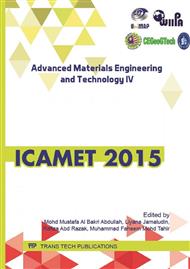p.499
p.503
p.509
p.514
p.519
p.524
p.530
p.535
p.540
Removal of Cadmium and Zinc Contaminations in Landfill Leachate by Using Electrocoagulation Process
Abstract:
The research works involve the study of removal of cadmium and zinc contaminations in landfill leachate by electrocoagulation process. This project focused on leachate landfill from Pulau Burung, Nibong Tebal, Penang as an electrolyte solution. Heavy metals are the main factor contributing to pollution in leachate landfill. Types of electrodes used in this study were aluminium (grade 5052) and Stainless Steel (grade 316). The ranges of initial pH applied were pH (3, 4, 5, 6 and 7) and voltages applied were 1.5V, 2.0V and 2.5V. At the end of electrocoagulation process, the solutions were stored and analysed usingatomic absorption spectroscopy (AAS) to determine the final concentration of electrolyte solution. It was found difference electrodes have difference effectiveness in removing heavy metals, relies on the types of electrodes (aluminium or stainless steel) and also types of heavy metals that were being treated. The initial pH also gives the significant effect to removal of heavy metal and the maximum voltages give higher removal of heavy metal. Removal of cadmium and zinc by stainless steel electrode was more effective than aluminium electrodes at voltage of 2.5V. The removal using stainless steel was 22.45% and 97.54% respectively. For removal using aluminium electrodes 18.37% and 92.12% respectively. It was found that the maximum voltages give higher removal of heavy metal for all removal of cadmium and zinc. The removal maximum when the applied voltage was 2.5V and minimum at 1.5V.
Info:
Periodical:
Pages:
519-523
Citation:
Online since:
May 2016
Keywords:
Price:
Сopyright:
© 2016 Trans Tech Publications Ltd. All Rights Reserved
Share:
Citation:


